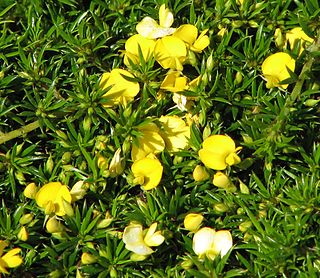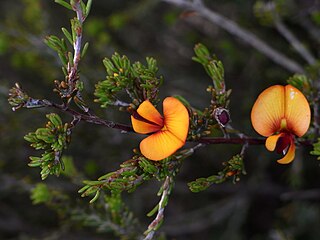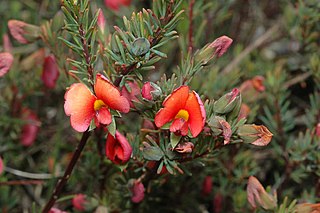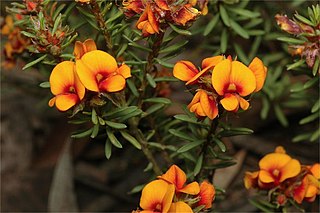
Pultenaea muelleri, commonly known as Mueller's bush-pea, is a species of flowering plant in the family Fabaceae and is endemic to Victoria, Australia. It is a dense shrub with hairy stems, elliptic to narrow egg-shaped leaves with the narrower end towards the base, and yellow and red flowers arranged singly or in pairs on the ends of short side shoots.

Pultenaea gunnii, commonly known as golden bush-pea, is a species of flowering plant in the family Fabaceae and is endemic to south-eastern Australia. It is a slender, erect to spreading shrub with hairy young stems, egg-shaped to lance-shaped leaves with lance-shaped stipules at the base, and bright yellow and dark red flowers.

Pultenaea juniperina, commonly known as prickly bush-pea or prickly beauty is a species of flowering plant in the family Fabaceae and is endemic to south-eastern Australia. It is an erect, spiky shrub with hairy stems, linear to narrow elliptic leaves with stipules at the base, and yellow-orange and red flowers.

Pultenaea tenuifolia, commonly known as slender bush-pea, is a species of flowering plant in the family Fabaceae and is endemic to southern Australia. It is a spreading or low-lying to prostrate and mat-forming shrub with hairy branches, narrow lance-shaped leaves, and yellow to orange and red, pea-like flowers.

Pultenaea pedunculata, commonly known as matted bush-pea, is a species of flowering plant in the family Fabaceae and is endemic to south-eastern Australia. It is a prostrate, densely matted shrub with softly-hairy branches that often form roots, narrow elliptic leaves, and bright yellow and brick-red flowers.

Pultenaea capitellata, commonly known as hard-head bush-pea, is a species of flowering plant in the family Fabaceae and is endemic to south-eastern continental Australia. It is a sprawling to prostrate shrub with elliptic to broadly egg-shaped leaves, and yellow to orange flowers with a red to purple keel.

Pultenaea cuneata is a species of flowering plant in the family Fabaceae and is endemic to eastern Australia. It is an erect shrub with triangular to egg-shaped leaves with the narrower end towards the base, and groups of yellow to orange and red to purple flowers.

Pultenaea dentata, commonly known as clustered bush-pea, is a species of flowering plant in the family Fabaceae and is endemic to south-eastern Australia. It is an erect to low-lying or prostrate, open shrub with elliptic to narrow egg-shaped leaves and dense clusters of yellow, red and purple flowers.

Pultenaea foliolosa, commonly known as the small-leaf bush-pea, is a species of flowering plant in the family Fabaceae and is endemic to eastern Australia. It is an erect to low-lying shrub with elliptic to oblong leaves that are concave on the upper surface, and yellow to orange and reddish-brown flowers.

Pultenaea glabra, commonly known as smooth bush-pea, is a species of flowering plant in the family Fabaceae and is endemic to eastern New South Wales. It is an erect shrub with glabrous stems, linear to egg-shaped leaves with a concave upper surface, and yellow to red and orange flowers.

Pultenaea humilis, commonly known as dwarf bush-pea, is a species of flowering plant in the family Fabaceae and is endemic to south-eastern Australia. It is a spreading, often low-lying shrub with branches that are hairy when young, elliptic to lance-shaped leaves with the narrower end towards the base, and yellow to orange and red flowers.

Pultenaea laxiflora, commonly known as loose-flower bush-pea, is a species of flowering plant in the family Fabaceae and is endemic to south-eastern continental Australia. It is a low-lying to prostrate, spreading shrub with linear to narrow egg-shaped leaves with the narrower end towards the base, and yellow and red to brown or purple flowers.

Pultenaea maritima, commonly known as coastal bush-pea or coastal headland pea, is a species of flowering plant in the family Fabaceae and is endemic to eastern Australia. It is a prostrate, mat-forming shrub with elliptic, or oblong to spatula-shaped leaves and pea-like flowers.

Pultenaea myrtoides is a species of flowering plant in the family Fabaceae and is endemic to eastern Australia. It is an erect shrub with egg-shaped leaves with the narrower end towards the base, pea-like flowers and flattened fruit.

Pultenaea petiolaris, commonly known as woolly bush-pea, is a species of flowering plant in the family Fabaceae and is endemic to eastern Australia. It is a low-lying shrub with linear leaves, pea-like flowers and flattened fruit.

Pultenaea prostrata, commonly known as silky bush-pea, is a species of flowering plant in the family Fabaceae and is endemic to south-eastern Australia. It is a small, rigid, wiry, low-lying or prostrate shrub with cylindrical leaves, and yellow, red and purple-brown flowers.

Gompholobium uncinatum, commonly known as red wedge pea, is a species of flowering plant in the family Fabaceae and is endemic to eastern Australia. It is a small, low-lying shrub with trifoliate leaves, the leaflets linear to narrow lance-shaped, and red, or orange-red and yellow-green, pea-like flowers.

Pultenaea subspicata, commonly known as low bush-pea, is a species of flowering plant in the family Fabaceae and is endemic to south-eastern continental Australia. It is a low-lying, prostrate or mat-forming shrub with elliptic leaves and yellow to pink and orange-red, pea-like flowers.
Pultenaea tenella, commonly known as delicate bush-pea, is a species of flowering plant in the family Fabaceae and is endemic to the high country near the border between New South Wales and Victoria in south-eastern continental Australia. It is a small, prostrate, mat-forming shrub with elliptic to linear leaves and yellow to orange and red, pea-like flowers.
Pultenaea villifera is a species of flowering plant in the family Fabaceae and is endemic to two disjunct areas of Australia. It is an erect to prostrate shrub with triangular to linear, egg-shaped to elliptic leaves and yellow and red, pea-like flowers.


















